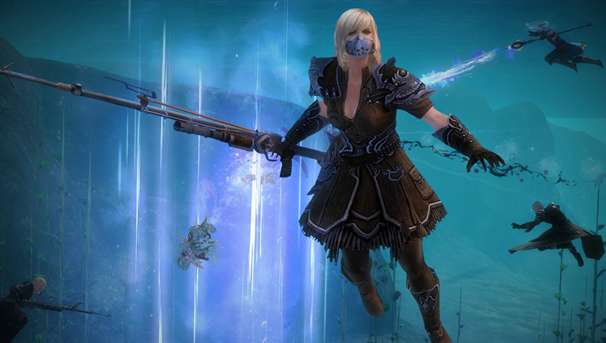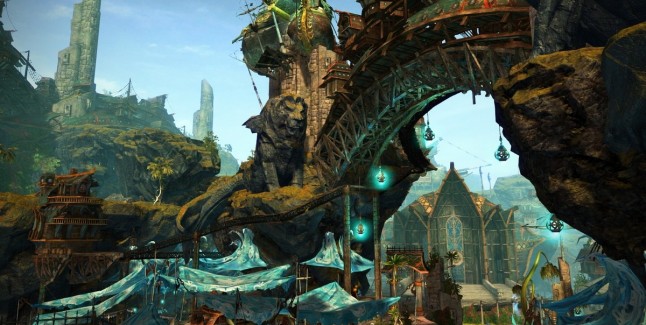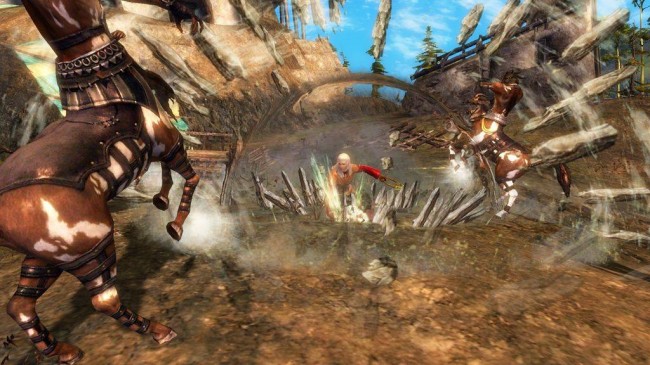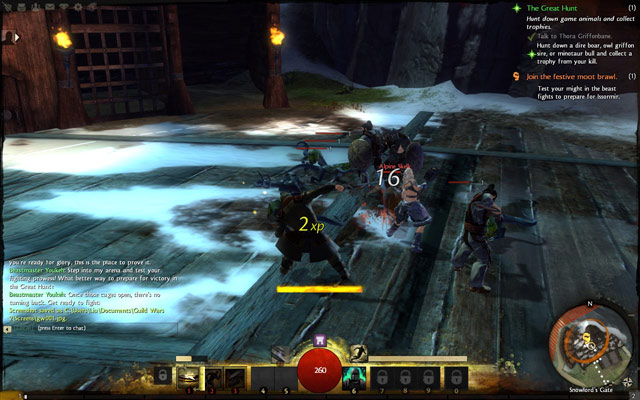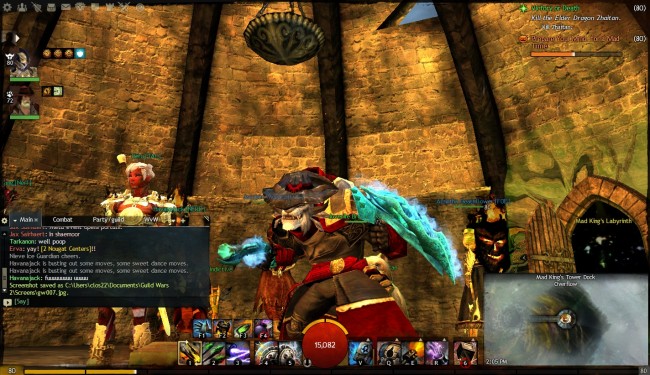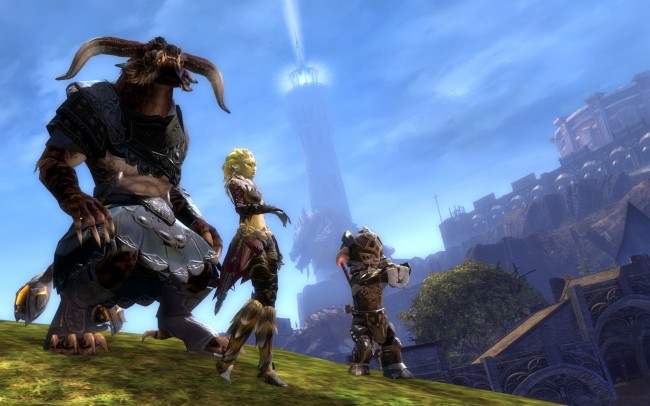Review: Guild Wars 2
/ I never thought I would get back into an MMO. I’ve played them for years and have completely lost interest with the standard MMO formula. Yet, when Guild Wars 2 was announced, I wanted to give it a chance. Arenanet’s promises about the features in the game were ambitious and completely out of every MMO player’s comfort zone. After years of development, the game has finally gone live, allowing players to populate the world of Tyria. After playing the game from day one up to the day I decided to sit down and finally write this review, I can honestly say that Guild Wars 2 is a step forward in the right direction for the MMORPG genre.
I never thought I would get back into an MMO. I’ve played them for years and have completely lost interest with the standard MMO formula. Yet, when Guild Wars 2 was announced, I wanted to give it a chance. Arenanet’s promises about the features in the game were ambitious and completely out of every MMO player’s comfort zone. After years of development, the game has finally gone live, allowing players to populate the world of Tyria. After playing the game from day one up to the day I decided to sit down and finally write this review, I can honestly say that Guild Wars 2 is a step forward in the right direction for the MMORPG genre.
Just like any MMO out there, the first thing that needs to be done is creating your first character. Aside from the usual customization options such as class, race, and visual appearance, you are given a set of questions that shapes your personal story. Instead of dumping the player into the big issues of the world right away, you are given a personal story that lets you experience your character rising up the ranks and becoming an important part of the main plot. When your personal story ends (Which is roughly halfway through), that’s when the pre-set story starts. The main plot, going against the elder dragons, is pretty straightforward. Guild Wars 2’s storytelling only shines through the personal stories. I was more interested on finding out what happened to my character’s father who was branded a traitor, rather than finding a way to defeat the elder dragons. This does not mean the characters or voice acting are bad, though. While the main plot of the game doesn’t draw you in enough to really give a damn, the characters you meet are quite memorable. From Zojja’s arrogant remarks to Warmaster Forgal’s comebacks when someone calls him old, the NPCs can bring a smile every now and then.
You will appreciate the overall presentation during the main story. You’ll also encounter a lot of cutscenes, mostly conversations between your character and various NPCs. All are well crafted and thankfully the lip-syncing was done well enough to provide the impression that they are really saying their words. Occasionally, you are treated to cinematics that use the amazing art assets of Guild Wars 2. You first witness one after finally creating your character and while it’s not the heavy graphics cinematics we are used to, the mixture of character models and designs used to create these presentations was so unique and artistic that it brought out the feeling that I was about to be part of an epic journey.
The excitement to see what happens next, though, ended for me when I stepped into the main plot, but thankfully, you are not required at all to do the main story’s quests. Finishing the main story was actually one of the last things I did.
The freedom to choose
This is one of the beauties of this game; you are given the choice to do whatever you want. Want some storytelling, go ahead. Want to not level and just do PVP at level 80, sure, jump right in. Want to go to war with other server, that’s possible too. After you complete your race’s epic introduction quest, you are placed on the first map and depending on what kind of player you are, you are just one click away from embarking on any of the main aspects of the game.
PVE is a bit different here. All you’ve got to do is explore and you will eventually find an ongoing event or task to participate in. Leveling is actually fun and it doesn’t end up being tedious. When done with a dynamic event or a task, you are rewarded on the spot based on how much you contributed, which saves so much time. If there is one thing I hate about the standard questing model, it’s traveling all the way back to the NPC to earn your reward. The fact that in Tyria you earn your experience and rewards on the spot keeps the momentum going. You are constantly moving forward.
If near the area, other players can participate anytime in any task and event, and their joining the event doesn’t take any experience from you; it actually makes it better at times. Since everybody gets their own loot and experience, nobody can complain, and it doesn’t get easier with more players as the event will scale based on the number of players in the area, so the challenge levels are still in check. Even if you don’t like being side by side with some random player, you will actually find yourself working together with these people as if you are in a group. The game encourages team play discreetly. For example, you just finished an event and it spawned a new one, only it requires the participation of a group in order to succeed. Wait just a few minutes and you will start noticing that players are flocking to the event to participate. Out of the blue, you have 20 players all ready to take on the group event. These events are everywhere and you are informed easily if there is one nearby.
Level scaling is one of the best features in this game by far. Let’s say you’re level 40 right now and wish to play with your buddy that’s currently level 10. You can actually go to his map and adventure with him, without ruining the fun for him, while at the same time not getting bored for joining. Going to a lower level map scales the higher level players down to the preferred level. It keeps the low level content still relevant and a bit challenging for a stronger player, and if you have not explored that low level area, it actually can turn out as new content for you thanks to the scaling. You’ll still have an edge since you have better gear, but don’t expect to be invincible – you will still need to bring your A-game. Oh, and the best part? You still have a chance of earning gear for your level.
There’s one thing I could not quite understand though – not having a personal trading system. I have no idea whatsoever as to why Arenanet chose to remove any form of trading between players. All we have is a mailing system that allows you to receive and send mails, anytime, anywhere. The mailing system is quick and effective, but I don’t get why they can’t add both. Guild Wars 2 does have online trading though, which is an equivalent to Auction Houses found in other MMOs. The Black Lion Trading Co. lets you sell your wares to anybody in the game, and I mean anybody. This trading store is linked to all servers, so it was actually unavailable for the first few days of the game’s release because the store was flooded with player orders. You can post your wares for sale, and if anybody is interested, they can buy them instantly. Your earnings can be picked up at the various trading posts in the game. Buying is just as quick and simple. Search the item you’re looking for, and if you like the price, press buy and it will be ready for pickup in any trading post. This trading post system is way more direct than the common auction house that allows players to either bid or straight up buy out the item.
The Black Lion Trading is also an online store if you wish to spend real money on the game. You may use real money to purchase gems, which can be used to buy online store items (mostly cosmetic) or be converted to in-game gold. What’s good about this system is that while you can convert real money into in-game gold, you can also do the exact opposite. If you wish to buy a cosmetic item on the online store with gems, you can convert your hard-earned gold to gems in order to purchase. So with this feature, everything can still be accessible without spending a dime.
Exploring is actually fun
Everything you do in this game rewards you for it. Explore, do crafting, revive some random player, completing Vistas, even chopping trees for materials, you will get experience for it. And if you do everything there is in the map, you get map completion rewards. You always feel like you’re moving forward in the game even when you’re getting sidetracked.
Exploring the game is quite a treat for the eyes as well. You can tell that Arenanet took its time to construct the world of Tyria once again for Guild Wars 2. The game looks amazing on high settings, and the visual details for each area in the game are quite impressive to look at. Since the game encourages you to explore, I really appreciated the level of detail they put into every single portion of the map. You do sense that grand scale. The environments all look different and have their own personality. Among the various cultures, each really stands out from the rest. Exploring the world is mostly bug-free as well. You will do a lot of jumping thanks to the vistas and jumping puzzles scattered across Tyria, and thankfully, they modeled the game well enough that you don’t see yourself unable to do them because there’s a hidden wall blocking your way.
Quality is definitely in check. You really feel that you are traveling through a rich and lively world. NPCs go about their day and make small talk about the issues in the area. Troubles abound everywhere and even when you don’t help out, life goes on. An event pops up that a bunch of centaurs are capturing a town. If no one helps, the centaurs actually take over the town and that event fails, but a new one pops up asking you to retake the town. With the town off the map, the waypoint to that area and all the merchants are gone until you complete the event.
Rather than looking for NPCs to give you quests, NPCs that need help go straight to you asking for a minute of your time so that they can tell you what’s wrong. You read that right. In Guild Wars 2, roles are reversed. Instead of the player seeking out NPCs with quests, they look for us. These are mostly seen in town, which encourages players to stop hanging around the towns and get out there.
Goodbye class roles
There’s so much variety in this game. Even the classes all have something unique, and their own style of play. Arenanet wanted to eliminate the holy trinity of MMOs (Tank, DPS, Healers) and you instantly see that right from the start. Each class has a little bit of everything. It’s either you go support, be tough, or go all-out damage. Every class can do it, so it’s all up to you. You don’t need a specific combination of classes to succeed in a specific context. This, again, makes playing with others easier. You won’t feel left out because you are this kind of ranger, or that kind of level.
The gameplay has a lot to do with player positioning. You always need to be on the move in this game, and if you can dodge an attack, do so. Double-tapping your movement keys or rather pressing the dodge button lets your character roll on the direction you choose. If done right, you can negate any incoming damage heading to you. To roll, you need to use endurance, represented by the bar above your life that’s enough for two dodges. Your endurance regenerates slowly, so you have to roll wisely. The fact that a lot of movement is required keeps every combat intense.
In Guild Wars 2, skills are set a bit differently. You have 10 skill slots: the first 5 slots are for your weapon skills, with your 6th slot being your heal skill. The next three are utility skills, and the final slot is for your elite skill. There are also unique skills located on the F-keys, dependent on the type of class you are playing. For example, if you are a Ranger, F1-F4 keys are used to control your pet, or for the warriors, F1 activates your adrenaline skill. Even underwater you are given a set of weapon skills suited for underwater combat. The switch to underwater skills is almost instant when you hit the water.
While the healing, utility, and elite slots can be changed at any time out of combat, the first 5 skills are based on the weapon you have equipped. Each class has a set of weapons they can use, and each one has different skills based on which hand they are on. If a warrior puts on a one-handed sword on his main hand, skills 1-3 will be sword skills. Then when you equip, let’s say, a shield on your off-hand, your 4 -5 skills are shield skills. Take out the shield and replace it with a one-handed axe and you’ll get 4-5 off-hand axe skills in addition to your sword skills. Equip a two-handed weapon, and that weapon will use all 5 weapon skills slots. To make things a bit more interesting, certain classes have the ability to swap weapons during combat, providing some pretty interesting combinations if done correctly. Make your warrior fire his rifle from afar, and when the enemy gets close, swap to your dual axes and start hacking away. If your character is using a weapon for the first time, you will need to keep using it to unlock all of its skills, though. Which is fine since it’s a good way to get a feel on what the weapon gives you as you slowly unlock its skills.
When you hit level 11, building your character gets deeper. You will start earning 1 trait point each time you level now, which can be added to the 5 trait lines for that specific class. With every 5 points invested in a trait line, you are given a passive trait, and every 10 points invested earns you a major trait slot. If you want your leveling even deeper, here you go: each point invested in a trait line also provides certain stat increases, so there’s a lot to think about when building your character.
If you’re interested in raiding, well, sorry, there is no raiding in Guild Wars 2. For you dungeon crawler junkies, there are 8 dungeons in the game that have two modes – Story Mode and Explore Mode. Story mode is a dungeon that tries to tell a story connecting the main characters. Next is Explore Mode, which is considered the hardest PVE content in the game. Each dungeon in Explore Mode will have three paths to choose from, and each path has a different set of events and bosses. So it’s like 3 dungeons in one, and they can be a pain if not with an organized group.
Since roles such as tanks, healers, and DPS are out of the picture, if not done right, the fights in Explore Mode can get chaotic pretty fast. This is for experienced players. The first Explore Mode is accessible once you hit level 35, so as long as you hit the level requirement, you can participate in what’s considered endgame, but be ready to carry your weight, since it’s not easy at all. Yet, don’t get discouraged if you’re a low level. I was able to successfully complete a path without level 80s, so yes, it’s possible. This was hard to get used to. With the lack of information in the game about Explore Mode, people will get surprised at the difficulty.
This is a big change in terms of dungeons and definitely needs work. Veteran MMO players used to the standard style will not feel comfortable with how the dungeons work in this game. Players will be shocked by the experience, so you need to keep an open mind. I had to throw what I know about MMO dungeons out the window to get used to these 5 main dungeons.
SPVP and World vs World
If you get bored with PVE or just want a change of pace, either World vs World or structured PVP will do. Let’s start with Structured PVP.
Structured PVP is completely separate from your PVE character. Regardless of what level you are in, once you enter the sPVP area, you are instantly scaled to level 80 with all of your skills unlocked. Since you are not allowed to use your PVE equipment, you are given a set of equipment which can be upgraded for free in any way you like. You can also change your traits and skills of your character anytime in the Heart of the Mist (PVP area). This allows you to play or experiment on your class any way you want in PVP. Once you get your build all sorted out, you can join any of the PVP servers to start playing. It’s usually an 8v8 match to capture 3 nodes in the map to earn points (Like Domination). The team with the most points at the end wins the match.
It’s currently the only mode in the game, which is sad. The current map count in Guild Wars 2 PVP is only four, which is definitely lacking. While they could add more maps in the future, I was hoping for more maps to play on from the get-go, since each match is quite fast and you can easily get bored playing the same map over and over. The biggest problem for sPVP at this point isn’t about the gameplay or the lack of maps and modes; playing PVP actually feels good. The problem is that there’s no other reason or incentive to keep playing the mode. The rewards given when you go up the ranks in PVP are mostly cosmetic. People interested in mostly PVE won’t bother too much with PVP since you don’t earn anything from it in the end. Not everybody is in it to play the game at a competitive level.
World vs World, though, is a different story. It is a battle between three game servers trying to dominate the four huge maps. This is MMORPG war at its finest since you have hundreds of players from each server, on each map, duking it out. It’s a three-way battle and it can get intense. There are keeps and towers to be captured, supply camps to defend, and siege weapons to build. This isn’t a team effort, but more like a server effort, since each match is a week-long. Each structure owned by your server earns your server points on the overall score. When you have more points, your server receives rewards such as more life and gathering bonuses. It’s pretty amazing to be a part of an epic siege with a hundred players breaking down a keep gate. To prevent matches from becoming unbalanced, winner servers for the week get bumped up in the rankings while losing servers go down.
Unlike in sPVP, your PVE gear are what you use for World vs World. If you are a low-level player, you get scaled up to 80 so you can be on equal ground with everybody else. The best part of World vs World is that you get to earn experience for your character. It’s another alternative to levelling, just in case you prefer progressing by owning players.
Small groups can still contribute to WvW. Fortifying towers and keeps, building sieges, and repairing all require supplies, which are provided by the supply camps scattered across each map. These are key to a server’s success. Having a supply camp under your server’s control will spawn supply caravans that take trips to the nearest keep or tower. A small group of players can retake supply camps and take down these supply caravans. While it doesn’t seem as epic as laying siege on a tower, you will see how strong of an effect cutting enemies’ supply lines can do after a couple of hours. Some people might not be in a guild focused on World vs World, but it’s great to know that you can still contribute even if you can only organize a small force.
If you don’t have a monster of a PC, then expect heavy FPS drops, because World vs World is very demanding. While I can run the game smoothly on high settings in other modes, all the players and effects going on during a large-scale battle could slow down performance and ruin the experience. There was one battle that included all three servers trying to take the only castle in World vs World. It was hard to fight, since the battle looked like a side-show on my screen. I’ve never seen that many people in one area doing all kinds of flashy skill effects.
Arenanet should be proud. They have created an amazing MMO game that breaks the standards of modern MMOs. The reward and questing systems are spot on, and teamwork has never been this fun in an MMO. Exploring the world of Tyria is actually rewarding and the visuals are absolutely stunning. Guild Wars 2 has it all – A rich and fluid PVE experience, a well-balanced PVP system, and a World vs World that is complex and demands further teamwork from players. It’s still hard to believe that an MMO with this kind of quality requires no subscription fees. Veteran MMO players, keep an open mind when you step into the world of Tyria. It is definitely a different game. It wants to be a different game.
Score: 95/100
Pros:
- Exploring the world is rewarding and fun
- Combat is fast and intense
- World vs World is a blast
- Level scaling based on the map you’re in
- Visuals are stunning
Cons:
- With a game filled with variety, PVP needs more of that
- Explore mode can be a shock to first-time players



